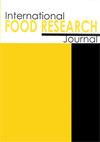乳酸菌种生化与分子鉴定方法的比较研究
IF 1
4区 农林科学
Q4 FOOD SCIENCE & TECHNOLOGY
引用次数: 0
摘要
在过去的几十年里,制造商希望销售“健康”食品,以回应消费者对健康生活方式的渴望,这增加了益生菌的使用。益生菌用于乳制品,以及非乳制品作为发酵剂,涵盖范围广泛的商品。许多表型,物理特征和基因分型技术已经发展,以确定益生菌乳酸菌,以确保质量管理。这些技术通常足够精确,可以按属和种对益生菌菌株进行分类。属和种鉴定最初采用传统的微生物学方法。然而,由于益生菌的能力往往依赖于菌株,并且无法使用简单的微生物学技术区分菌株,因此主要基于核酸检查的新方法已经开发出来。因此,本综述的目的是对现有的鉴定乳酸菌属成员的方法以及新发现的方法提供关键的评估。本综述旨在提供用于测量和描述微生物可能的益生菌特性的科学技术的最新信息。它还将强调分子和非分子工具。这些工具大多基于16S核糖体DNA测序,并采用PCR技术。本文章由计算机程序翻译,如有差异,请以英文原文为准。
Comparative study on biochemical and molecular identification approaches of Lactobacillus species
Manufacturers’ desire to sell “healthy” food in response to the consumers’ desire to lead a healthy lifestyle has increased the use of probiotics during the past few decades. Probiotics are used in dairy products, as well as non-dairy items as a starter culture, encompassing a wide range of goods. Numerous phenotyping, physical characterisation, and genotyping techniques have been developed to identify probiotic lactobacilli to ensure quality management. These techniques are frequently precise enough to categorise probiotic strains by genus and species. Traditional microbiological methods were initially employed for genus and species identification. However, due to their numerous shortcomings as the probiotic ability is often strain-dependent, and that there is no way to differentiate between strains using simple microbiological techniques, new methods that are mostly based on the examination of nucleic acids have been developed. Therefore, the objective of the present review was to provide critical assessment on existing methods for identifying members of the genus Lactobacillus, together with newly discovered approaches. The present review aimed to give the most recent information on the scientific techniques used to measure and describe the possible probiotic properties of microorganisms. It will also emphasise molecular and non-molecular tools. Most of these tools are based on 16S ribosomal DNA sequencing, and employ PCR techniques.
求助全文
通过发布文献求助,成功后即可免费获取论文全文。
去求助
来源期刊

international food research journal
Agricultural and Biological Sciences-Food Science
CiteScore
1.40
自引率
0.00%
发文量
75
期刊介绍:
The International Food Research Journal (IFRJ) publishes papers in English, six (6) issues a year with the coverage of:
Food Science and Technology
Nutrition and Dietetics
Agriculture, multidisciplinary
Chemistry, multidisciplinary
The scope of the Journal includes:
Food Science, Food Technology and Food Biotechnology
Product Development and Sensory Evaluation
Food Habits, Nutrition, and Health
Food Safety and Quality
Food Chemistry, Food Microbiology, Food Analysis and Testing
Food Engineering
Food Packaging
Food Waste Management
Food Entrepreneur
Food Regulatory
Post-Harvest Food Management
Food Supply Chain Management
Halal Food and Management
 求助内容:
求助内容: 应助结果提醒方式:
应助结果提醒方式:


